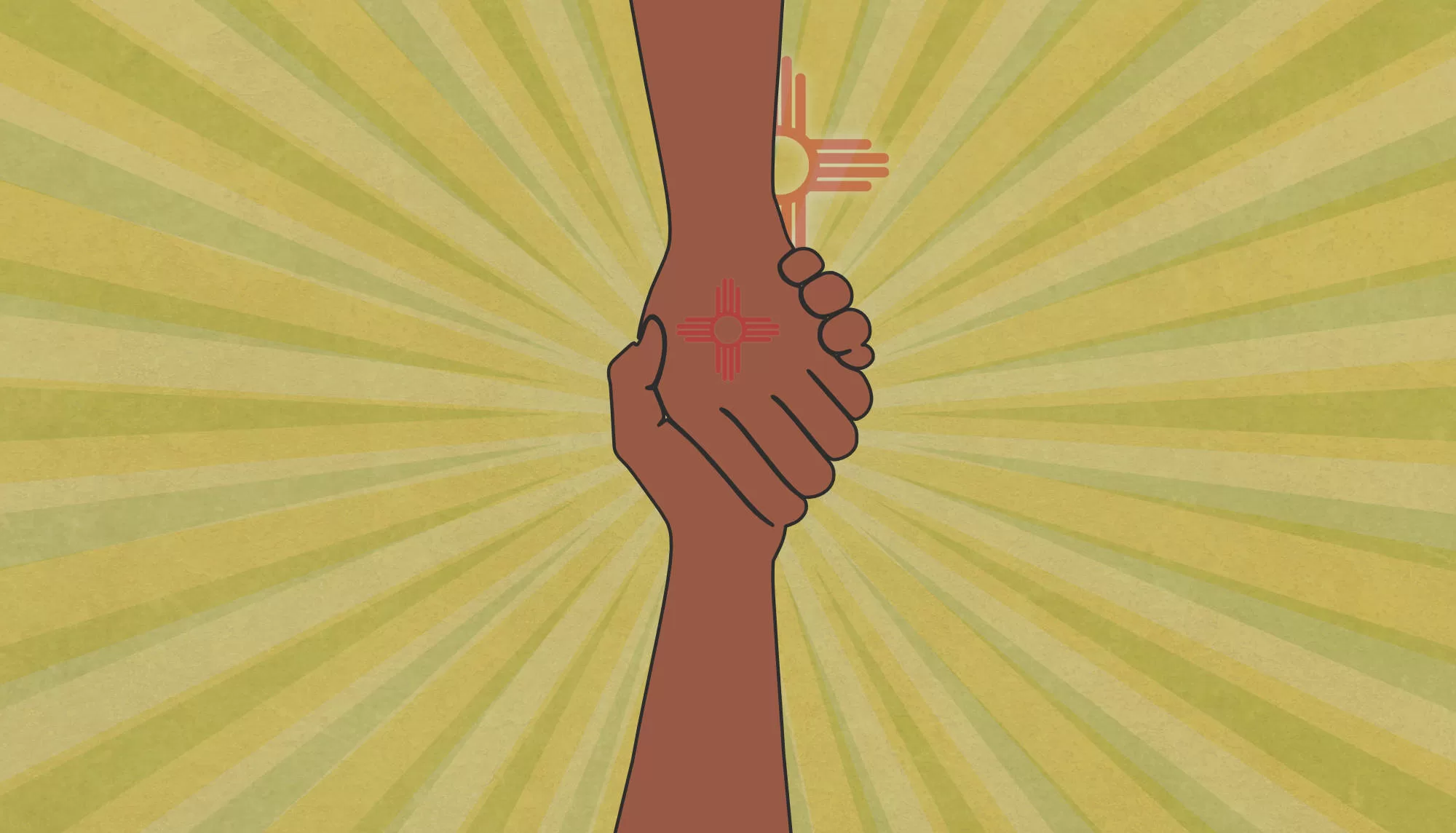Why Counties Turn to School-Based Health Care
If the pandemic taught us anything, it’s that we need to strengthen our statewide system of health care. School-based health turns each school into a hub for accessible care for students and their families. We ask Nancy Rodriguez with the New Mexico Alliance for School-Based Health about her mission.
Before the pandemic hit, we knew our students were vulnerable to many challenges that hurt their chances to achieve academically. These problems included adverse childhood experiences (ACEs), including ten forms of potentially traumatizing forms of adversity, abuse, and neglect. We also know, from our countywide surveys, that students may live in communities where access to vital services for surviving and thriving may be out of reach–including medical care and mental health care.
When the pandemic hit, we saw how vulnerable we all were. It became very clear, very fast, that each county needed a robust system of health care providers in order to ensure testing, support with quarantining, medical care, and eventually vaccines. As we look to strengthen our local systems of care, we seek to explore the role school-based health centers can have in times of a future public health crisis, as well as how these centers serve the entire school community in so-called “normal” times.
We asked Nancy Rodriguez, executive director of the New Mexico Alliance for School-Based Health Care about her agency’s mission and her vision for a future when every student has access to quality school-based care. We also share with readers a funding opportunity.
Question: What brought you to the New Mexico Alliance for School-Based Health Care and taking a leadership position?
Nancy Rodriguez: I started on the educational support side of the education system and saw how lack of accessible health care impacted students and the entire school community. It was clear to me that if we don’t address unmet health care needs we won’t achieve educational goals for all our students. For this reason, I was drawn to the school-based health care model.
Question: What is the mission of the New Mexico Alliance for School-Based Health Care?
Nancy Rodriguez: The Alliance represents school-based health centers (SBHCs) in New Mexico and collaborates with other partners to promote, facilitate and advocate for comprehensive, integrated, and culturally competent health care, including health education, in schools. Our vision is a New Mexico where 100% of students are healthy and ready to learn.
Question: Can you share your organization’s core values?
Nancy Rodriguez: We believe in universal access to affordable, high quality health care provided in schools and communities because good health is essential for student success, and health care, like public education, is a right. We are advocating for the health of children and youth and for the provision of high quality, accessible, confidential, comprehensive, integrated, and culturally competent health care in schools.
Question: Can you share how your core values align with the goals of health equity and inclusion?
Nancy Rodriguez: School-based Health Centers made health equity possible by making care accessible in a place – the school – where our students and their families have access. Our centers are committed to providing all with the care to students that empowers them to achieve academically. Our staff believe in celebrating diversity in the community of students, parents, providers, and schools.
Question: How are school-based centers funded?
Nancy Rodriguez: We believe that SBHCs, as a valuable component of the health care delivery system, should be appropriately funded and reimbursed. To achieve our goal of providing quality school-based care local school stakeholders, along with health equity advocates, collaborate to identify funding from the following sources: the state, local and federal sources. We also find partners in philanthropy.
Question: What is the status of school-based health centers in New Mexico?
Nancy Rodriguez: In New Mexico there are more than 70 school-based health centers (SBHCs), which provide quality health services to students, where students are — in school. That is out of 877 schools in 146 school districts.
The history of, and reasons for, school-based health centers are important to understand. SBHCs are important safety net clinics in New Mexico, providing easily accessible health care when, in many cases, the closest clinic or hospital may be miles away. A statewide, multi-partner work group created the official SBHC Definition, Description, and Defining Characteristics in 2015. Since its creation, several state agencies have agreed to use it as their designation of a school-based health center.
Over the past few decades, the growth of SBHCs came about to address various public health needs, evolving into a collaborative model of care that is sensitive to the unique needs of students. SBHCs were also developed to meet the needs of vulnerable populations facing significant barriers to access. Evaluation of the SBHC model of care has been shown to demonstrate increased access to care, improved health and education outcomes, and high levels of satisfaction.
Question: What are the qualities of a New Mexico School-Based Health Center?
Nancy Rodriguez: School-based health centers provide quality, integrated, youth-friendly, and culturally responsive health care services to keep children and adolescents healthy, in school, and ready to learn. A SBHC is a health clinic located on or near school property that functions separately from and in cooperation with the school nurse’s office. The SBHC includes a team of qualified multidisciplinary professionals (typically employed by a community-based health organization) that supports the health, well-being, and success of students. The SBHC enables children/adolescents to thrive in the classroom and beyond.
The center’s health care providers and the physical characteristics of the center can vary based on student need and facility resources, among other influencing factors. The ideal SBHC model includes integrated physical and behavioral health care services. At a minimum, primary care, including urgent, acute, prevention, and wellness care, is at the core. In addition to behavioral health, expanded services, including, substance abuse support, dental health, reproductive health, nutrition education, case management, and health promotion may also be offered at the SBHC. SBHCs provide a youth-friendly environment designed to meet the unique health care needs of all youth, through supportive and collaborative relationships with youth, families, school administration, school health staff (school nurse, school counselor, health educator, etc.), school districts, and boards.
Question: The ACEs Study revealed in their 1998 publication that, as the number of ACEs increases, so does the risk of physical and emotional challenges that can diminish students’ capacity to learn. ACEs related trauma in youth can continue into adulthood impacting job readiness and risk for substance use disorders. According to the NM 2019 BRFSS Survey of adults, 23.8% of New Mexicans endured four or more ACEs. The top four ACEs reported were emotional abuse, having parents divorced or separated, physical abuse, and having a household member who was a problem drinker or alcoholic. To educators and health care providers, this means that 1 out of 4 students are at serious risk for a host of ACEs-related challenges. How can a SBHC, specially school-based behavioral health care, better equip a school to address adverse childhood experiences (ACEs) and trauma in order to help students and their families overcome adversity and achieve academically?
Nancy Rodriguez: Without school-based medical and behavioral health care for students and their parents, addressing the challenges may become near impossible. We know from the 100% New Mexico countywide surveys that in some communities, as many as half the parents surveyed reported difficulty accessing mental health care services. School-based health care is the solution. Properly funded and staffed, ACEs can be addressed in the school-based health center. School-based health care is the most practical way to create a statewide system to prevent and treat ACEs and trauma.
Question: What role does your Alliance have with policy and advocacy?
Nancy Rodriguez: We support community stakeholders across New Mexico who are supportive of school-based health centers, especially those whose priority is to seek local, state, federal, and philanthropic support to open and sustain SBHCs. Although many communities have made progress in establishing SBHCs, far more children, youth, and families could benefit from school-based health care. The New Mexico Alliance for School-Based Health Care works to impact administrative, legislative, and organizational policies at the local, state, and federal levels that support kids and school health.
Each year, we create a policy agenda, and take positions on relevant legislation, with the goal of advancing health and learning through the expansion and sustainability of SBHCs and school health services.
Question: With our 100% New Mexico initiative, we have local action teams focused on strengthening the community schools model, along with school-based health centers that align their services with local community providers. Can you share a little about the relationship between advocates for SBHCs and advocates for community schools?
Nancy Rodriguez: There is growing interest and collaboration on the local level between advocates for both school-based health centers and community schools. For those schools that are community schools, there is on-going dialogue about meeting the health needs of students by the development of a school based health center. The philosophy of community schools is that it should be a place that addresses all the health issues that might impact academic achievement as well as parent engagement.
For those schools with health centers, staff are very aware of the community schools model and can become advocates for transforming a school into a fully resourced community school that has school-based care.
Question: Can you share a funding opportunity for those seeking to support SBHS?
Nancy Rodriguez: Thanks to funding from NMDOH/OSAH, we are offering $10-20K grants to schools or medical entities that wish to expand SBHC services. This opportunity to be funded will allow grantees to assess and plan for expansion of services, including new brick and mortar SBHCs, new hours of services at existing SBHCs, new telehealth services, and new mobile services. The deadline for applications is April 8, 2022. (See: https://www.nmasbhc.org/our-work/technical-assistance/funding-opportunity/)
Goals of the 2022 New Mexico SBHC Planning Grants:
- Facilitate expansion of SBHCs, where needed, throughout New Mexico.
- Identify gaps that exist for child and adolescent physical, mental, and social health needs.
- Determine the need and readiness of the school and community for an SBHC model of care.
- Facilitate school system, health care system, and community collaboration to develop a plan to address gaps in child and adolescent health.
- Prepare grantee to apply for New Mexico Department of Health funding for opening a SBHC or expanding SBHC services in Spring 2023.
Question: Our 100% New Mexico initiative, working on the county level, is designed to have a Community Schools Action Team, as well as a Medical/Dental Care Action Team and Behavioral Health Action Team. These team members would benefit greatly from aligning with the work of your Alliance. What is the best way for school-based and community-based health advocates to connect with you to support your mission?
Nancy Rodriguez: Visit us at our website to discuss how we can collaborate in each county and school to increase care through the SBHS model. You can also learn more about the health and safety risk of students by visiting NM Youth Risk and Resilience Survey. We look forward to collaborating.
Mission: The 100% New Mexico initiative is dedicated to ensuring that 100% of families can access ten vital services crucial for their overall health, resilience, and success. This university-sponsored endeavor necessitates the local implementation of evidence-based strategies encompassing both community and school-based service hubs, aiming to prevent the most pressing and costly public health and safety challenges, including adverse social determinants of health and adverse childhood experiences.
Don’t miss a blog post! Get notified!
The 100% New Mexico initiative is a program of the Anna, Age Eight Institute at New Mexico State University, College of Agricultural, Consumer and Environmental Sciences, Cooperative Extension Service. Contact: annaageeight@nmsu.edu or visit annaageeight.nmsu.edu to learn more.





